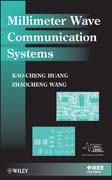
The aim of this book is to present the modern design and analysis principles of millimeter-wave communication system for wireless devices and to give postgraduates and system professionals the design insights and challenges when integrating millimeter wave personal communication system. Millimeter wave communication system are going to play key roles in modern gigabit wireless communication area as millimeter-wave industrial standards from IEEE, European ComputerManufacturing Association (ECMA) and Wireless High Definition (Wireless HD) Group, are on their way to the market. The book will review up-to-date researchresults and utilize numerous design and analysis for the whole system covering from Millimeter wave frontend to digital signal processing in order to address major topics in a high speed wireless system INDICE: Chapter1 Millimeter wave Characteristics. 1.1 Millimeter wave characterizations. 1.2 Channel performance at 60 GHz. 1.3 Gigabit wireless communications. 1.4 Development of millimeter wave standards. 1.5 Co-existence with wireless backhaul. Chapter2 Review of modulations for mm-wave communications. 2.1 On/Off Keying (OOK). 2.2 Phase shift keying (PSK). 2.3 Frequency shift keying (FSK). 2.4 Quadrature amplitude modulation (QAM). 2.5 Orthogonal frequency division multiplexing (OFDM). Chapter3 Millimeter wave Transceivers. 3.1 Millimeter wave link budget. 3.2 Transceiver architecture. 3.3 Transceiver without mixer. 3.4 Receiver without local oscillator. 3.5 Millimeter wave calibration.3.6 Research trend: transceiver siliconization. Chapter4 Millimeter wave Antennas. 4.1 Path loss and antenna directivity. 4.2 Antenna beamwidth. 4.3 Maximum possible Gain-to-Q. 4.4 Polarization. 4.5 Beam steering antenna. 4.6 Millimeter wave design consideration. 4.7 Production and manufacture. Chapter5 Millimeter wave MIMO. 5.1 Spatial diversity of antenna arrays. 5.2 Multiple antennas. 5.3 Multiple transceivers. 5.4 Noise coupling in a MIMO system. Chapter6 Advanced Diversity over MIMO Channels. 6.1 Potential benefits for millimeter wavesystems. 6.2 Spatial and temporal diversity. 6.3 Spatial and frequency diversity. 6.4 Dynamic spatial, frequency and modulation allocation. Chapter7 Advanced Beam Steering and Beam Forming. 7.1 The need for beam steering/beam forming. 7.2 Adaptive frame structure. 7.3 Advanced beam steering technology. 7.4 Advanced antenna ID technology. 7.5 Advanced beam forming technology. Chapter8 Single Carrier Frequency Domain Equalization. 8.1 Advantages of SC-FDE over ODSMfor millimeter wave systems. 8.2 Preamble design. 8.3 Adaptive channel estimation. 8.4 Frequency domain equalization. 8.5 Decision feedback equalization.
- ISBN: 978-0-470-40462-1
- Editorial: John Wiley & Sons
- Encuadernacion: Cartoné
- Páginas: 272
- Fecha Publicación: 10/12/2010
- Nº Volúmenes: 1
- Idioma: Inglés
